check engine AUDI RS5 COUPE 2015 Owner's Manual
[x] Cancel search | Manufacturer: AUDI, Model Year: 2015, Model line: RS5 COUPE, Model: AUDI RS5 COUPE 2015Pages: 254, PDF Size: 64.12 MB
Page 195 of 254
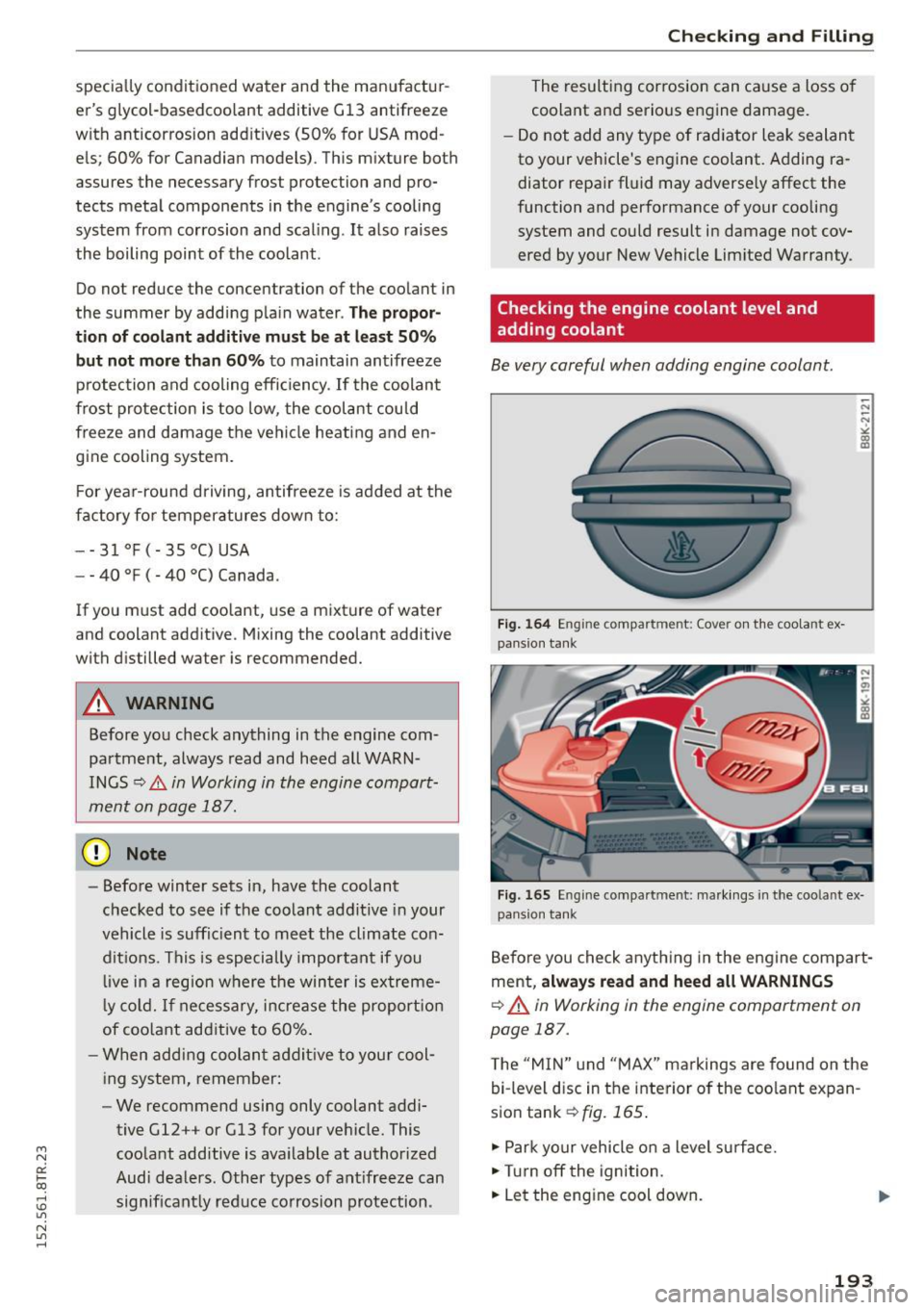
"' N
0:: loo
rl I.O
"' N
"' rl
specially conditioned water and the manufactur
er's glycol-basedcoolant additive Gl3 antifreeze
with anticorrosion add itives (50% for USA mod
els ; 60% for Canadian models) . This mixture both
assures the necessary frost protection and pro
tects metal components in the engine's cooling
system from corrosion and scaling . It also raises
the boiling point of the coolant .
Do not reduce the concentration of the coolant in
the summer by adding pla in water .
The propor
ti on of coolant additive mu st be at least 50 %
but n ot more than 60 °/o
to maintain antifreeze
p rotec tion and cooling efficiency . If the coolan t
frost protection is too low, the coolant cou ld
freeze and damage the vehicle heating and en
gine cooling system.
F or year-round driving, antifreeze is added at the
factory for temperatures dow n to:
- - 31 °F (-35 °C) USA
- - 40 °F ( - 40 °C) Canada .
If you m ust add coolant, use a m ixture of water
and coolant additive. Mixing the coolant additive
with distilled water is recommended.
A WARNING
Before you check anything in the engine com
partment, always read and heed all WARN
INGS
~ A in Working in the engine compart
ment on page 187.
(D Note
- Before winter sets in, have the coolant
checked to see if the coolant additive in your
vehicle is suffic ient to meet the climate con
dit ions . This is especially important if you
l ive in a region where the winter is ex treme-
l y co ld. I f necessary, increase the proport ion
of coo lant add itive to 60%.
- When adding coolant addit ive to your cool
ing system, remember:
- We recommend using only coolant addi
tive Gl2 ++ or Gl3 for your vehicle. This
coola nt add itive is ava ilable at authorized
Audi dea lers. Other types of ant ifreeze can
significant ly reduce corrosion protection .
Check in g and Fillin g
The resulting corrosion can cause a loss o f
coolant and serious engine damage.
- Do not add any type of rad iator leak sealant
to your vehicle's engine coolant . Adding ra
diator repair fluid may adverse ly affect the
function and performance of your cooling
system and could result in damage not cov
ered by your New Vehicle Limited Warranty .
Checking the engine coolant level and
adding coolant
Be very careful when adding engine coolant.
Fig . 1 64 Engine compartment: Cover on the coo lant ex
pans io n tank
Fig . 1 65 Engin e compa rtment: mark in gs in t he coo lant ex
pan sion tank
Before you check anything in the engine compart
ment,
a lwa ys read and heed all WARNINGS
~ A in Working in the engine compartment on
page 187.
The "MIN" und "MAX" markings are found on the
bi-level d isc in the interior of the coo lant expan
s ion tank~
fig. 165 .
.,. Park yo ur vehicle on a level su rface.
.,. Turn off the ignition.
.,. Let the engine cool down.
193
Page 196 of 254
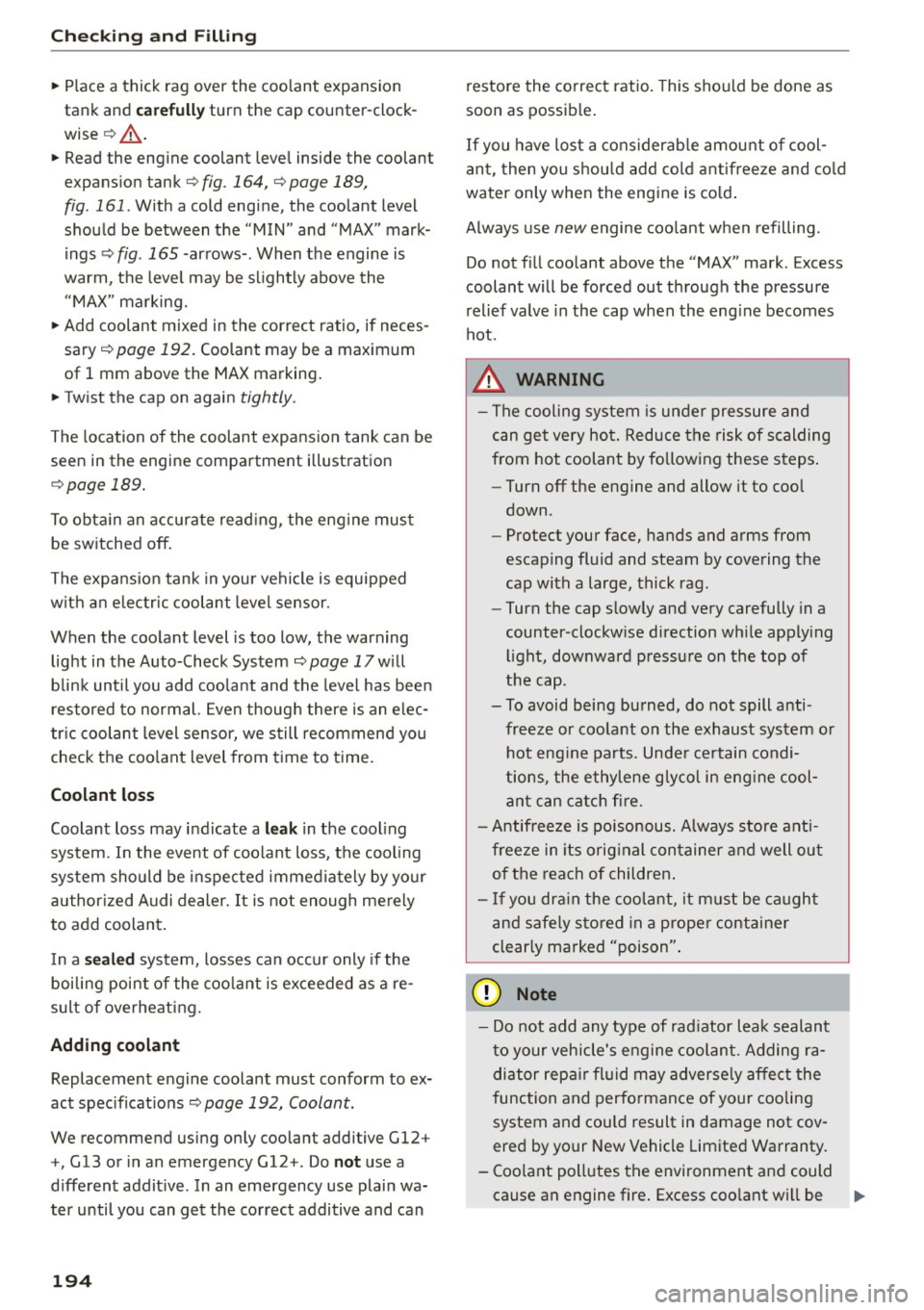
Checking and Filling
"' Place a thick rag over th e coolant expansion
tank and
carefully turn the cap counter-clock
wise
¢ ,& .
"'Read the engine coolant level inside the coolan t
expansion tank
¢ fig . 164, ¢page 189,
fig. 16 1.
With a cold engine , the coolant level
should be between the ' 'MIN" and "MAX " mark
ings
¢ fig . 165 -arrows- . When the engine is
warm, the level may be slightly above the
"MAX" marking.
"'Add coolant mixed in the correct ratio, if neces
sary ¢
page 192 . Coolant may be a maximum
of 1 mm above the MAX marking.
"' Twist the cap on again
tightly .
The location of the coolant expansion tank can be
seen in the engine compartment illustration
¢ page 189.
To obtain an accurate reading , the engine must
be switched off.
The expansion tank in your vehicle is equipped
with an electric coolant level sensor.
When the coolant level is too low, the warning
light in the Auto-Check System¢
page 17 will
blink until you add coolant and the level has been
restored to normal. Even though there is an elec
tric coolant level sensor, we still recommend you
check the coolant level from time to time.
Coolant loss
Coolant loss may indicate a leak in the cooling
system. In the event of coolant loss, the cooling
system should be inspected immediately by your
authorized Audi dealer. It is not enough merely
to add coolant.
In a
sealed system, losses can occur only if the
boiling point of the coolant is exceeded as a re
sult of overheating.
Adding coolant
Replacement engine coolant must conform to ex
act specifications ¢
page 192, Coolant.
We recommend using only coolant additive Gl2+
+ , G l3
or in an emergency Gl2+ . Do not use a
different additive . In an emergency use plain wa
ter until you can get the correct additive and can
194
restore the correct ratio. This should be done as
soon as possible.
If you have lost a considerable amount of cool
ant, then you should add cold antifreeze and cold
water only when the engine is cold.
Always use
new engine coolant when refilling.
Do not fill coolant above the "MAX" mark. Excess
coolant will be forced out through the pressure
relief valve in the cap when the engine becomes
hot.
,&_ WARNING
- The cooling system is under pressure and
can get very hot. Reduce the risk of scalding
from hot coolant by following these steps.
- Turn off the engine and allow it to cool
down .
- Protect your face, hands and arms from
escaping fluid and steam by covering the
cap with a large, thick rag .
- Turn the cap slowly and very carefully in a
counter-clockwise direction while applying
light, downward pressure on the top of
the cap .
- To avoid being burned, do not spill anti
freeze or coolant on the exhaust system or
hot engine parts. Under certain condi
tions, the ethylene glycol in engine cool
ant can catch fire.
- Antifreeze is poisonous. Always store anti
freeze in its original container and well out
of the reach of children.
- If you drain the coolant, it must be caught
and safely stored in a proper container
clearly marked "poison".
(D Note
- Do not add any type of radiator leak sealant
to your vehicle's engine coolant. Adding ra
diator repair fluid may adversely affect the
function and performance of your cooling
system and could result in damage not cov
ered by your New Vehicle Limited Warranty.
- Coolant pollutes the environment and could
-
cause an engine fire. Excess coolant will be .,.
Page 197 of 254
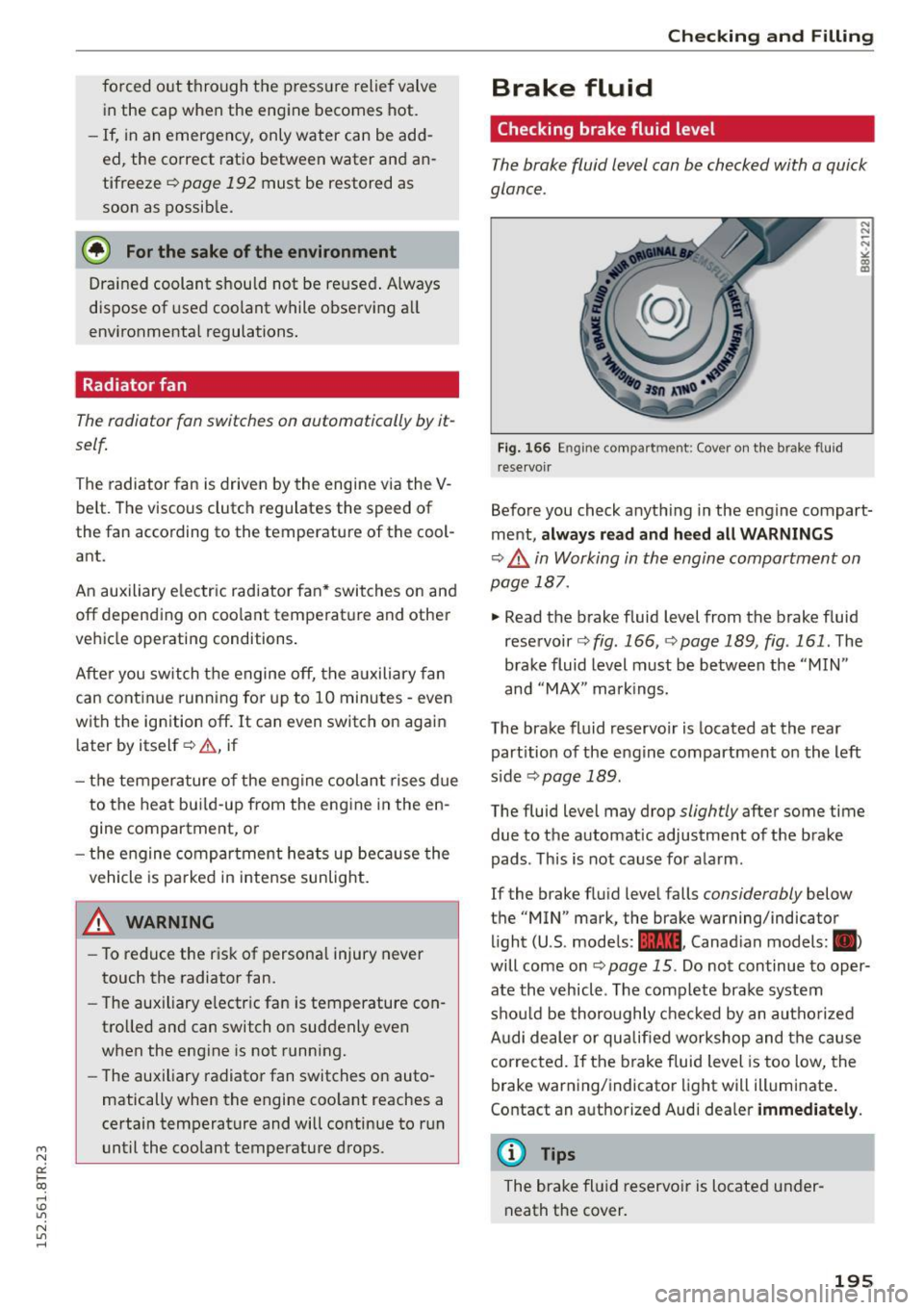
"' N
0:: loo
rl I.O
"' N
"' rl
forced out through the pressure relief valve
in the cap when the engine becomes hot.
- If, in an emergency, only water can be add
ed, the correct ratio between water and an
tifreeze
q page 192 must be restored as
soon as possib le.
@ For the sake of the environment
Drained coolant should not be reused . Always
dispose of used coolant while observ ing a ll
environmental regulations.
Radiator fan
The radiator fan switches on automatically by it
self.
The radiator fan is driven by the engine via the V
be lt. The viscous clutch regulates the speed of
the fan according to the temperature of the cool
ant.
An auxiliary e lectr ic radiator fan * switches on and
off depending on coo lant temperature and other
veh icle operating conditions.
Afte r you switch the engine off, the a uxiliary fan
can cont inue running for up to 10 minutes -even
with the ignition off. It can even switch on again
l ater by itself
Q .&. , if
- the temperature of the engine coolant rises due
to the heat bui ld-up from the eng ine in the en
gine compartment, or
- the engine compartment heats up because the
vehicle is parked in intense sunlight.
_& WARNING
- To reduce the r isk of personal injury never
touch the radiator fan.
- The aux iliary e lectr ic fan is temperature con
trolled and can switch on suddenly even
when the engine is not running.
- The auxiliary radiator fan switches on auto
matically when the engine coo lant reaches a
certain temperature and will continue to run
until the coolant temperature drops.
Ch eck in g and Fillin g
Brake fluid
Checking brake fluid level
The broke fluid level con be checked with a quick
glance.
F ig . 1 66 Engine compartment: Cover on the brake fluid
r eservoir
Before you check anyth ing in the engine compart
ment,
a lw ays r ead and h eed all WARNING S
q ,& in Working in the engine compartment on
page 187.
., Read the brake fluid level from the brake fluid
reservoir
q fig. 166, r:> page 189, fig. 161. The
brake fluid level must be between the "MIN"
and "MAX" markings.
The brake fluid reservo ir is located at the rear
part ition of the engine compartment on the left
s ide
q page 189.
The fluid level may drop slightly after some time
due to the automatic adjustment of the brake
pads. This is not cause for alarm.
If the brake fluid level falls
considerably below
the "MIN" mark, the brake warning/indicator
light (U.S. models:
1111 , Canad ian models: .
will come on
Q page 15 . Do not continue to oper
ate the vehicl e. The complete brake system
shou ld be thoroughly chec ked by an autho rized
A udi dealer or qualified workshop and the cause
corrected. If the brake fluid level is too low, the
brake warning/indicator light will illuminate .
Contact an a uthorized Audi dea ler
immedi ately .
(0 Tips
The brake fl uid reservoir is located under
neath the cover.
195
Page 200 of 254
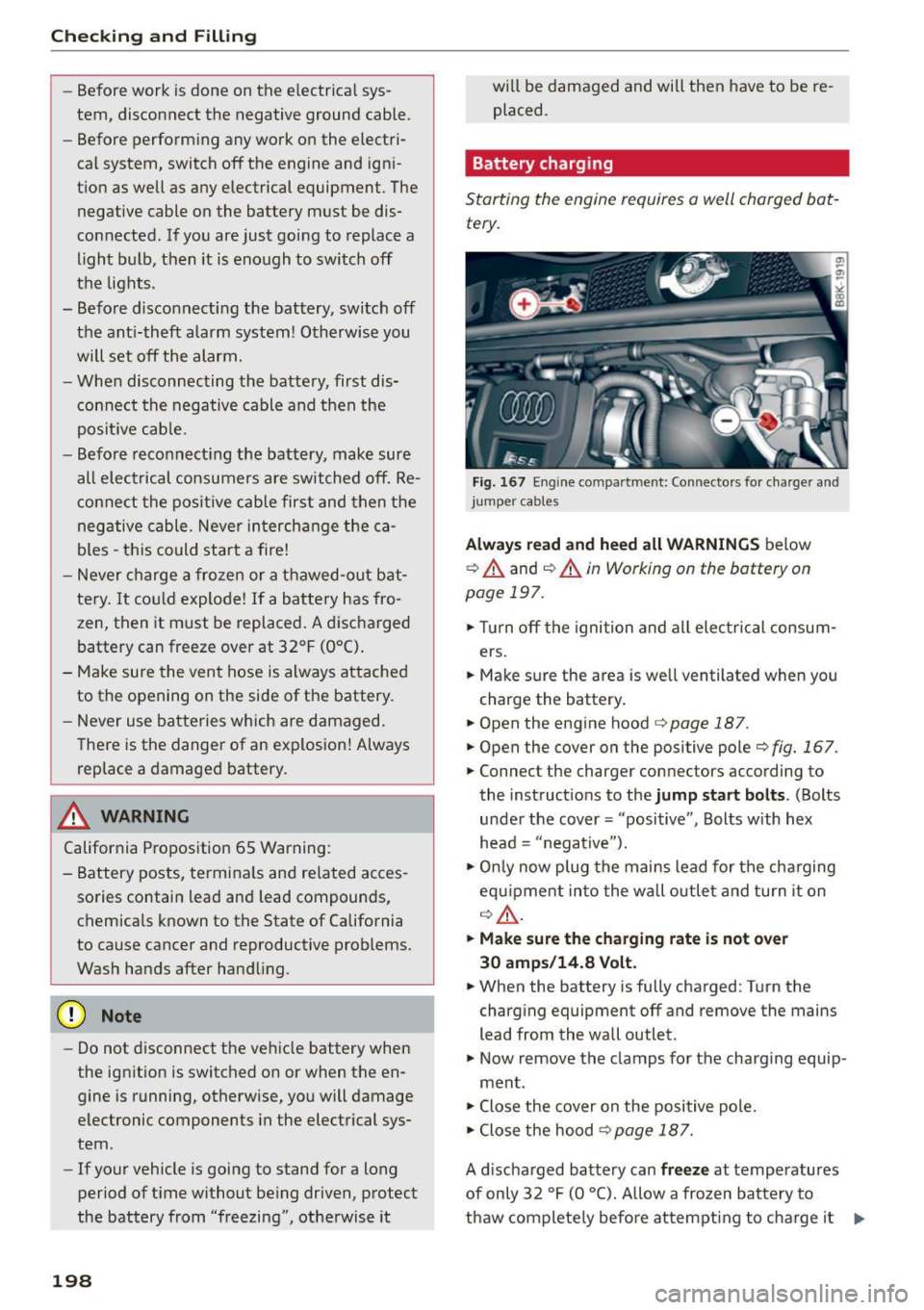
Checking and Filling
-Before work is done on the electrical sys
tem, disconnect the negative ground cable .
- Before performing any work on the electri
cal system, switch off the engine and igni
tion as well as any electrical equipment. The
negative cable on the battery must be dis
connected . If you are just going to replace a
light bulb, then it is enough to switch off
the lights.
- Before disconnecting the battery, switch off
the ant i-theft alarm system! Otherwise you
will set off the alarm.
- When disconnecting the battery, first dis
connect the negative cable and then the
positive cable.
- Before reconnecting the battery, make sure
all electrical consumers are switched off. Re
connect the positive cable first and then the
negative cable. Never interchange the ca
bles -this could start a fire!
- Never charge a frozen or a thawed-out bat
tery. It could explode! If a battery has fro
zen, then it must be replaced. A discharged
battery can freeze over at 32°F (0°C) .
- Make sure the vent hose is always attached
to the opening on the side of the battery.
- Never use batteries which are damaged.
There is the danger of an explosion! Always
replace a damaged battery.
A WARNING
California Proposition 65 Warning:
- Battery posts, terminals and related acces
sories contain lead and lead compounds,
chemicals known to the State of California
to cause cancer and reproductive problems.
Wash hands after handling.
(D Note
- Do not disconnect the vehicle battery when
the ignition is switched on or when tile en
gine is running, otherwise, you will damage
electronic components in the electrical sys
tem.
- If your vehicle is going to stand for a long
period of time without being driven, protect
the battery from "freezing", otherwise it
198
will be damaged and will then have to be re
placed.
Battery charging
Starting the engine requires a well charged bat
tery.
Fig. 167 Eng ine compartment: Connectors for charger and
jumper cables
Always read and heed all WARNINGS below
¢
A and ¢ A in Working on the battery on
page 197.
.,. Turn off the ignition and all electrical consum
ers.
.,. Make sure the area is well ventilated when you
charge the battery.
.,. Open the engine hood
¢ page 187.
.,. Open the cover on the positive pole¢ fig. 167.
.,. Connect the charger connectors according to
the instruct ions to the
jump start bolts . (Bolts
under the cover= "positive", Bolts with hex
head = "negative").
.,. Only now plug the mains lead for the charging
equipment into the wall outlet and turn it on
¢ &, .
.,. Make sure the charging rate is not over
30 amps/14.8 Volt.
.,. When the battery is fully charged : T urn the
charging equipment off and remove the mains
lead from the wall outlet.
.,. Now remove the clamps for the charging equip -
ment .
.,. Close the cover on the positive pole.
.,. Close the hood¢
page 187.
A discharged battery can freeze at temperatures
of only 32 °F (0 °C). Allow a frozen battery to
thaw completely before attempting to charge it
Ill>
Page 201 of 254
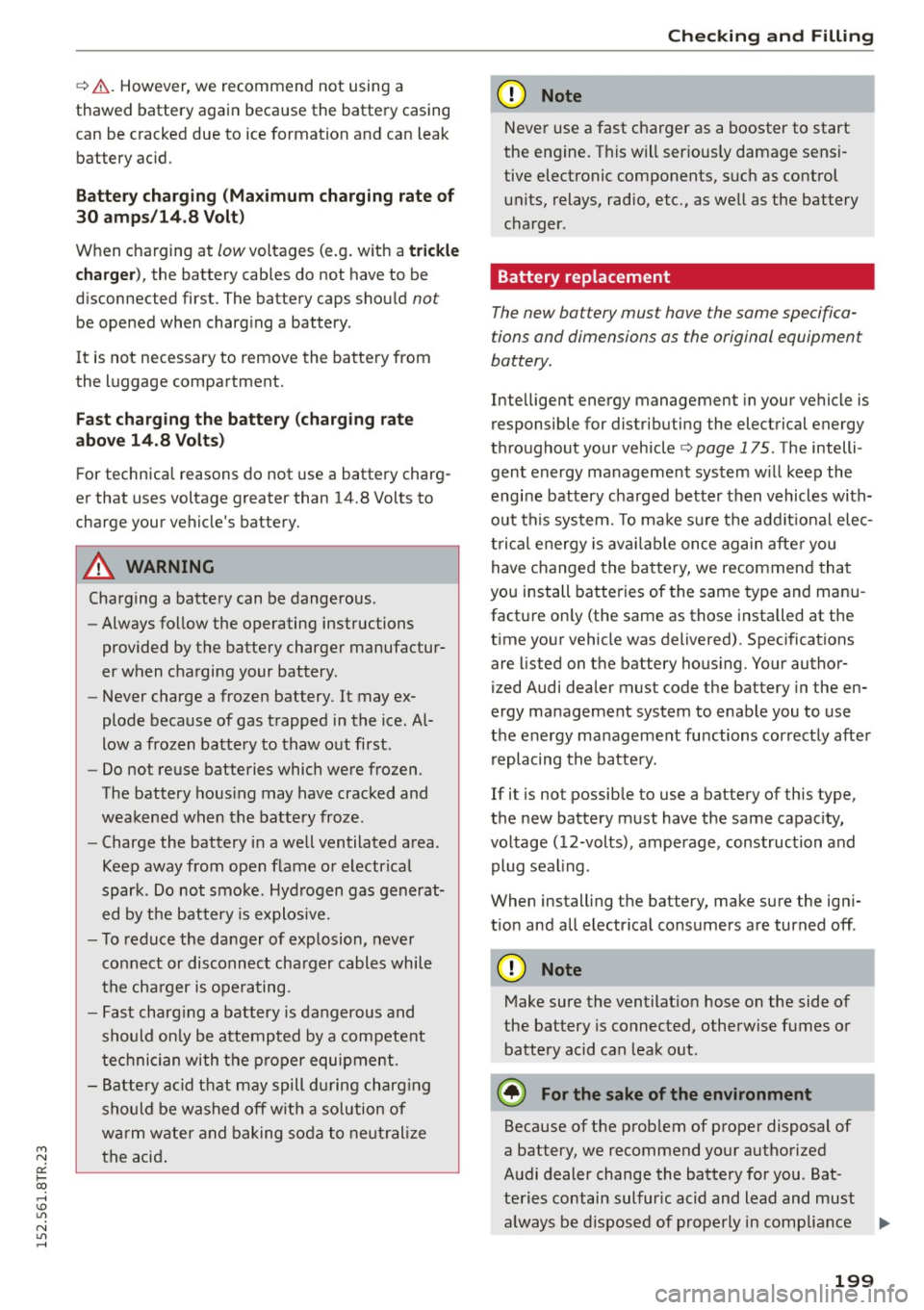
M N
0:: loo ,...., \!) 1.1'1
N 1.1'1 ,....,
q &.. However, we recommend not using a
thawed battery again because the battery casing
can be cracked due to ice formation and can leak
battery acid.
Batt ery chargi ng (Maximum cha rging rate of
30 amp s/14 .8 Volt )
When charging at
low voltages (e.g. with a trickl e
cha rger ), the battery cables do not have to be
d isconnected first. The battery caps shou ld
not
be opened when charg ing a battery.
It is not necessary to remove the battery from
the luggage compartment.
Fast charging th e battery (char ging rat e
above 14 .8 Vo lt s)
For technical reasons do not use a battery charg
er that uses voltage greater than 14.8 Volts to
charge your vehicle's battery.
A WARNING
Charging a battery can be dangerous.
- Always follow the operating instructions
provided by the battery charger manufactur
er when charging your battery.
- Never charge a frozen battery. It may ex
plode because of gas trapped in the ice. Al
low a frozen battery to thaw out first.
- Do not reuse batteries which were frozen.
The battery hous ing may have cracked and
weakened when the battery froze.
- Charge the battery in a well ventilated area.
Keep away from open flame or electrical
spark. Do not smoke. Hyd rogen gas generat
ed by t he battery is explos ive.
- To reduce the danger of explosion, never
co nnect or disconnect cha rger cables while
the cha rger is operating.
- Fast charg ing a battery is dangerous and
should only be attempted by a competent
tec hnician with the p roper equipment.
- Battery acid that may spill du ring charg ing
sho uld be washed off w ith a so lution of
wa rm w ater and baking soda to ne utralize
the acid .
Checking and Fillin g
(D Note
Never use a fast charger as a booster to start
the engine . This will ser iously damage sensi
tive electronic components, s uch as control
units, relays, radio, etc., as well as the battery
charger.
Battery replacement
The new battery must hove the some specifica
tions and dimensions as the original equipment
battery.
Intelligent energy management in your vehicle is
responsible for distributing the electrical energy
t h roughout your vehicle
q page 175. The intelli
gent energy management system w ill keep the
engine battery charged better then vehicles with
out this system. To make s ure the addit ional elec
t rical energy is ava ilab le once again afte r yo u
have changed the battery, we recommend that
you install batteries of the same type and man u
facture on ly (the same as those insta lled at the
t ime yo ur vehicle was delivered). Specifications
are listed on the battery hous ing. Your author
ized Audi dealer must code the battery in the en
ergy management system to enab le you to use
the e nergy management fu nctions correctly after
replacing the battery.
If it is not possib le to use a battery of this type,
the new battery must have the same capac ity,
voltage ( 12-volts), amperage, construction and
plug sealing.
When installing the battery, make sure the igni
t ion and all electr ica l consumers are turned off.
(D Note
Make sure the ventilat ion hose on the side of
the battery is connected, otherwise fumes or
battery acid can leak out.
@ For the sake of the environment
Because of the prob lem of proper disposal of
a battery, we recommend your authorized
Audi dealer change the battery for you. Bat
teries contain sulfur ic acid and lead and must
a lways be d isposed of properly in compliance ..,.
199
Page 202 of 254

Checking and Fill in g
with all environmental reg ulations. D isposing
of vehicle batteries improperly is
very danger
ous to the env ironment.
Windshield/headlight*
washer container
F ig . 168 Engin e com partm en t: Cover o n the win d shi eld
and head lig ht• was he r fl ui d co ntainer
The washer flu id container is marked with the
symbo l~ on its cap
~fig . 168 , ~ page 189,
fig . 161.
(") N
-N
"' co a,
• Before you check anyth ing in the eng ine com
partment,
alw ay s re ad and he ed all WARN
IN GS ~ ,& in Working in the engine compart
ment on page 187 .
• Lift the fi ller cap tong ue to add w asher fl uid .
You can fill the container to the top.
• Press the cap back onto the filler neck after f ill-
ing the container .
You ca n find the rese rvoir
c apa city in the tab le in
~ page 234.
Clean water sho uld be used when fill ing up . If
possible, use soft water to prevent sca ling on the
washer jets. Always add a glass cleane r solu tion
(with frost protection in the winter) .
@) Note
Do not mix engine coo lant antifree ze or any
other add itives to fi ll up the windshie ld wash
er reservoir .
200
Page 221 of 254

M N
0:: loo ,...., \!) 1.1'1
N 1.1'1 ,....,
A WARNING 1=
You or your passengers cou ld be injured while
chang ing a wheel if you do not follow these
safety precautions:
- If you have a flat t ire, move a safe distance
off the road . Turn off the engine, turn the
emergency flashers on and use other warn
ing devices to alert other motorists.
- Make sure that passengers wait in a safe
place away from the vehicle and well away
from the road and traff ic.
- To help prevent the veh icle from mov ing
sudden ly and possibly slipping off the jac k,
always fully set the pa rking brake and block
the whee l diagona lly opposite the w heel be
ing changed with the folding chocks or oth
er objects. When one front wheel is lifted
off the ground, placing the Automatic Trans
mission in "P" (Park) will
not prevent the ve
hicle from moving.
- Before you change a wheel, be sure the
ground is level and firm. If necessary, use a
sturdy board under the jack.
- Always store the vehicle tool kit, the jack *
and the replaced tire in the luggage com
partment
c> page 117.
(D Note
If you are changing the wheel on a steep in
cline, use a rock or sim ilar object to block the
opposite whee l to prevent the vehicle from
mov ing.
{!) Tips
Obey a ll laws.
Changing a wheel
When you change o wheel, follow the sequence
described below step-by-step and in exactly that
order.
1. Remove the wheel bolt caps*. F or more de
tails see also ¢
page 220 , Wheels with
wheel bolt caps .
2. Loosen the wheel bolts¢ page 220.
Emerge ncy ass is tanc e
3. Locate the proper mounting point for the
jack and alig n the jack below that point
¢ page 221 .
4. Lift the car with the jack¢ page 221.
5. Remove the wheel with th e fla t tire and then
install the other wheel¢
page 222 .
6. Tighten all whee l bolts lightly.
7 .
Lower the vehicle with the jack .
8. Use the wheel bolt wrench and
firmly t ighten
all wheel bo lts in a crisscross pattern
¢page 220.
9. Replace the wheel bolt cap s* .
A WARNING
A lways read and fo llow all WARNINGS and in
formation
¢ &. in Raising the vehicle on
page221
and ¢page 223.
After changing a wheel
A wheel chonge is not complete without the do
ing the following.
.. Always store the vehicle tool kit, the jack*, and
the replaced tire in the luggage compartment
¢ page 117.
.. As soon as possib le, have the t ightening tor
ques
on all wheel bolts checked with a torque
wrench . The correct t ightening to rque is 90 ft
lbs. (120 Nm) .
.. Have the flat tire
replaced as soon as possible .
(D Tips
-If you not ice that the wheel bo lts a re cor
roded and difficult to tur n while changing a
tire, they should be replaced before you
check the tigh tening torque.
- Dr ive at reduced speed until you have the
tightening to rques che cked.
219
Page 230 of 254
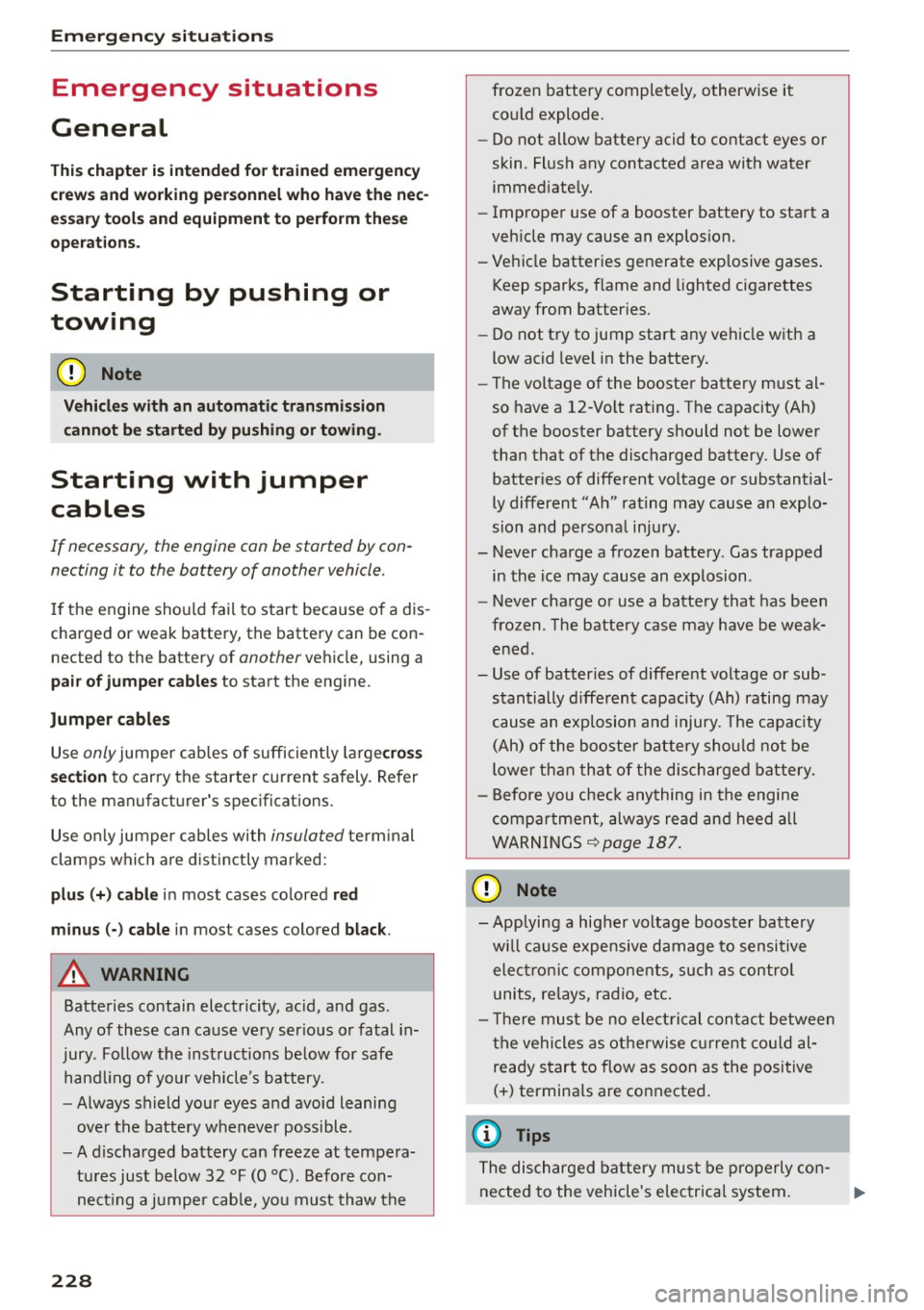
Emerg enc y s it uat ion s
Emergency situations
General
T his c hapt er is inte nded fo r tra ined e merg ency
c rews a nd worki ng p ers onn el w ho h ave the nec
e ssa ry tool s and equipm ent t o perf orm the se
op era tion s.
Starting by pushing or
towing
CD Note
Vehicl es with an automa tic tra nsmission
c annot be st arted by pushing or towing .
Starting with jumper
cables
If necessary, the engine con be started by con
necting it to the battery of another vehicle .
If the engine should fail to start because of a d is
charged or weak battery, the battery can be con
nected to the battery of
another vehicle, us ing a
p air of j umpe r cables to start the engine.
Jump er c abl es
Use only jumper cab les of sufficiently largec ross
sec tion
to carry the starter current safely. Refer
to the manufacturer's specifications.
Use on ly jumper cables with
insulated term inal
clamps which are d istinctly mar ked:
plus (+ ) cabl e in most cases co lored re d
minu s(-) cable
in most cases colored black .
A WARNING
Batteries contain electricity, ac id, and gas.
Any of these can cause very ser ious or fatal in
jury . Fo llow the inst ruct ions be low for safe
hand Ling of your veh icle's battery.
- Always shield your eyes and avoid leaning
over the battery whenever possible.
- A discharged battery can freeze at tempera
tures just below 32 °F (0 °C). Before con
nect ing a jumper cab le, you must thaw the
228
frozen battery completely, otherwise it
could explode.
- Do not allow battery acid to contact eyes or
skin. Flush any contacted area with water immed iately.
- Improper use of a booster battery to start a
veh icle may cause an explosion.
- Vehicle batteries generate explosive gases .
Keep sparks, flame and lighted cigarettes
away from batteries.
- Do not try to jump start any vehicle with a
low acid level in the battery.
- The voltage of the booster battery must al
so have a 12-Volt rat ing . The capacity (Ah)
of the booster battery should not be lower
than that of the discharged battery. Use of batter ies of different voltage or substantial
ly different "Ah" rating may cause an explo
sion and personal injury .
- Never charge a frozen battery . Gas trapped
in the ice may cause an explosion .
- Never charge or use a battery that has been
frozen . The battery case may have be weak
ened .
- Use of batter ies of different voltage or sub
stantially d ifferent capacity (Ah) rating may
cause an explosion and injury. The capacity
(Ah) of the booster battery sho uld not be
lowe r than that of the discharged battery.
- Before you check anything in the engine
compartment, always read and heed a ll
WARNINGS
qpoge 187.
CD Note
-App lying a higher voltage booster battery
wi ll cause expensive damage to sensitive
elec tronic components, such as control
units, re lays, radio, etc.
- T here must be no electrical contact between
the vehicles as otherwise cu rrent cou ld al
ready start to flow as soon as the positive
(+) termina ls are connected.
@ Tips
The discharged battery must be properly con-
nected to the vehicle's electrical system. .,.
Page 232 of 254

Emergency situation s
-The ba ttery ce ll lockin g screws must be
t ightened securely .
- Before you check anyt hing in the engine
compartment, always read and heed all
WARNINGS
c> page 187.
(D Note
Improper hook -u p of jumper cables can r uin
the generator .
- A lways connect POS ITIV E(+ ) to POS ITIV E
( + ), and NEGATIVE( -) to NEGATIVE( -)
gro und post of the battery manager control
unit .
- Check that a ll screw plugs o n the batte ry
ce lls are screwed in firmly . If not, tighten
pl ugs prior to connect ing clamp on negat ive
battery te rminal.
- Please note that the procedure for connect
i ng a jumper cable as desc ribed above ap
plies specifica lly to the case of yo ur vehicle
being jump started . W hen you a re g iving a
j u mp sta rt to another vehicl e, do
not co n
ne ct the negative ( -) cab le to the negative
( -) t erminal o n the di scharged battery @
c> fig. 18 8 . In stea d, secure ly co nn ect the
nega tive ( -) cab le to either a solid me tal
com ponent that is f irm ly bolted to the en
gine block o r to t he engine bloc k itself. I f
the battery that is being charged does not
vent to the outside , escap ing battery gas
could ignite and exp lode!
Towing with a tow truck
General hints
Y o ur Audi requires special handling for towing.
The fo llow ing information is to be used by com
mercia l tow truck operato rs who know how to op
erate their eq uipment safe ly .
- Never tow your Audi, towing will cause dam
age to the engine and transmiss ion.
- Never wrap the safety chains or winch cables
around the brake lines .
- To pre vent unnecessary damage, your Audi
must be transported with a flat bed truck.
230
- To load the vehicle on to the flat bed , use the
towing loop found in the vehicle tools and at·
tach to the front or rear anchorage
c> page 230 and c:>page 231.
A WARNING
A veh icle being towed is not safe f or passe n
gers . Never a llow anyone to ride in a ve hicle
be ing towed, fo r any reason .
Front towing loop
Do not install the front towing loop until it is
needed .
Fig. 18 9 Fro nt b um per: remov ing t he cove r cap
Fig. 190 Front b umper: sc rew ing in t he tow ing loop
The towing loo p fits in to the threade d hole locat
ed on the right side o f the front bum per and cov
e red by a small cover when not in use .
.,. Remove the tow ing loop fr om the vehicle tool
ki t
c> page 216.
... Take ho ld of the bot tom edge o f the cover cap
and pull it out of the bumpe r
9fig . 189 .
... Sc rew the tow ing loop t ightly into the threaded
hole as far as it will go
c> fig. 190 and t ighten it
with the wheel wrench . ..,.
Page 234 of 254
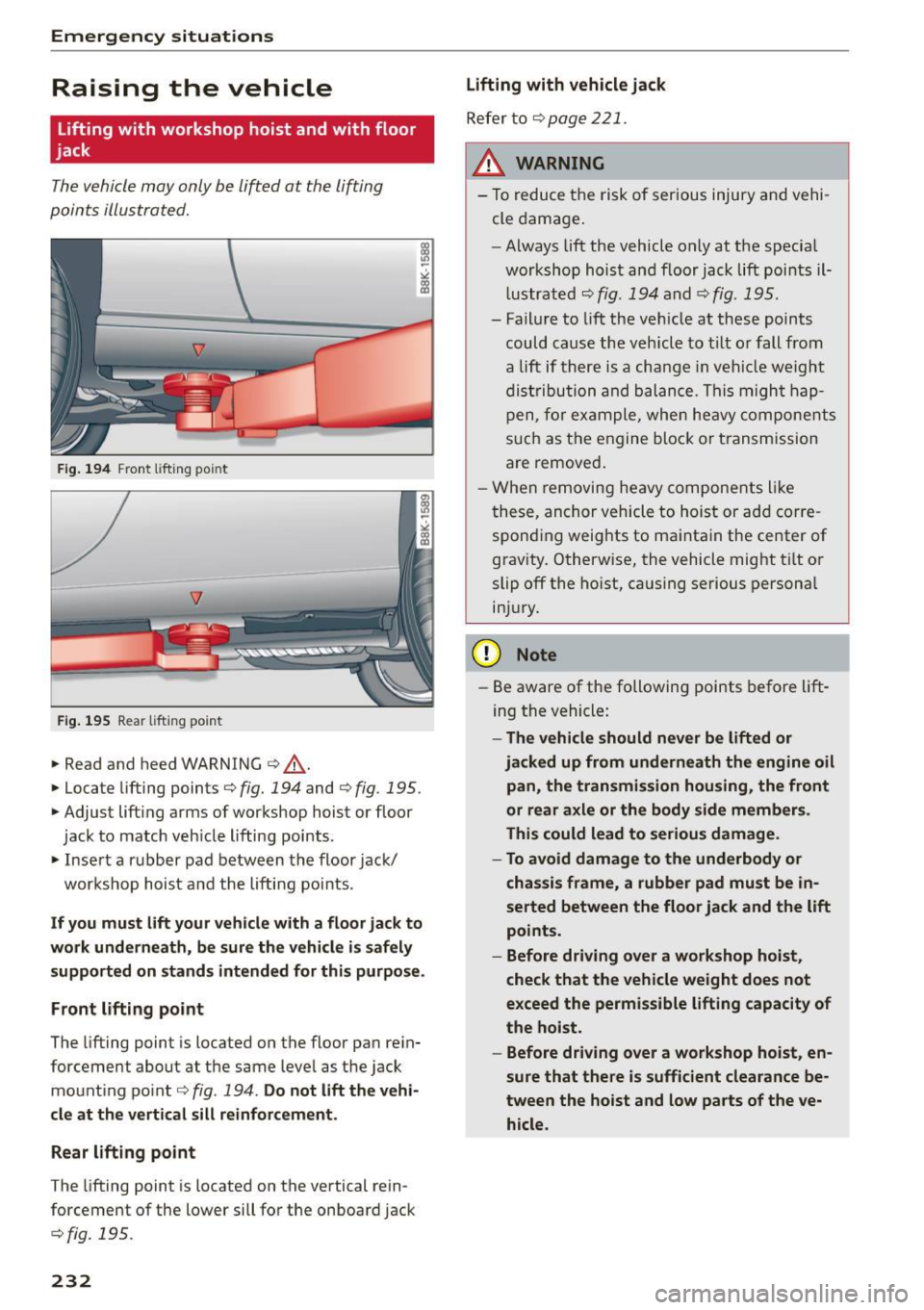
Emergency situation s
Raising the vehicle
Lifting with workshop hoist and with floor
jack
The v ehicle may only be lifted at the lifting
points illustrated.
F ig . 1 94 Front lift in g po int
F ig . 1 95 Rear l ift ing po int
... Read and heed WARNING c> &_ .
... Locate lifting points c> fig. 194 and c> fig . 195.
... Adjust lift ing arms of workshop hoist or floor
jack to match veh icle lifting points.
... Inse rt a r ubber pad between the floor jack/
workshop hoist and the lifting points .
If you must lift your vehicle with a floor jack to
work underneath, be sure th e vehicle is safely
supported on stands intended for this purpo se.
F ront l ifting point
The lifting point is located on the floor pan rein
forcement about at the same leve l as the jack
mount ing po int
c> fig . 194 . Do not lift the vehi
cle at the vertical sill reinforcement .
Rear lift ing point
The lifting point is located on the vertical rein
forcement of the lower sill fo r the on board jack
c>fig. 195.
232
Lifting with vehicle jack
Refer to c::> page 221.
A WARNING
- To reduce t he risk of serious injury and vehi
cle damage .
- Always lift the vehicle only at the specia l
workshop hoist and f loor jack lift points il
l ustrat ed
c::> fig . 194 and c> fig. 195.
-Failure to lift the veh icle a t these points
could cause the veh icle to tilt o r fall from
a lift if th ere is a cha nge in vehi cle we ight
dis tribu tio n and balance. T his m ight hap
p en, for example, whe n he avy compone nts
s uch as the en gine block or tran smission
are removed .
- W hen removing he avy componen ts like
these, anchor vehicle to hoist or ad d corre
spond ing weights to ma intain the center of
grav ity . Otherwise, the vehicle might ti lt o r
slip off the ho ist , causing se rious persona l
in jury .
(D Note
-Be aware of the following points before lift
ing the vehicle:
- The veh icle should never be lifted or
jacked up from underneath the engine oil pan, the transmis sion housing, the front
or rear axle or the body side members .
This could lead to serious damage .
- To avoid damage to the underbody or
chas sis frame , a rubber pad must be in
serted between the floor ja ck and the lift
points.
- Before driving over a workshop hoist,
check that the vehicle weight doe s not
exceed the permissible lifting capacity of
the hoist.
- Before driving over a work shop hoist , en
sure that the re is sufficient clearance be
tween the hoist and low parts of the ve
h icle.